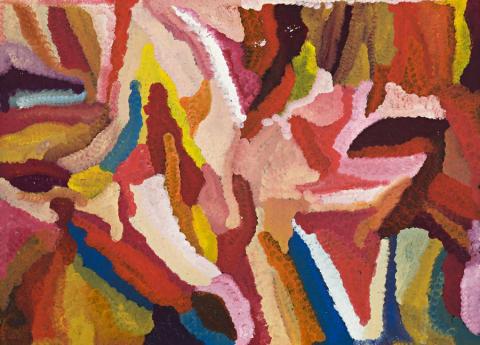UNTITLED, 1992
EMILY KAME KNGWARREYE
synthetic polymer paint on canvas
164.0 x 228.0 cm
inscribed verso: artist's name, 'Rodney Gooch' and Mulga Bore Artists cat. 4892
Mulga Bore Artists, Alice Springs
Hugh Jamieson Collection
Private collection, New South Wales
Deutscher and Hackett, Melbourne, 18 May 2011, lot 12
Private collection, Perth
Emily Kame Kngwarreye: Alhalkere: Paintings from Utopia, Queensland Art Gallery, Brisbane, 20 February – 13 April 1998; Art Gallery of New South Wales, Sydney, 15 May – 19 July 1998; National Gallery of Victoria, Melbourne, 8 September – 22 November 1998, (label attached verso)
Utopia: The Genius of Emily Kame Kngwarreye, National Museum of Art, Osaka, 26 February – 13 April 2008; National Art Centre, Tokyo 28 May – 28 July 2008, cat. C-10
Neale, M., Emily Kame Kngwarreye: Alhalkere: Paintings from Utopia, Macmillan publishers, Melbourne, pp. 106–107, pl. 67, cat. 54 (illus.), p. 43 (illus., detail)
Neale, M., (ed.), Utopia: The Genius of Emily Kame Kngwarreye, National Museum of Australia and the National Museum of Art, Osaka, pp. 149, 162, cat. C-10 (illus.)
Emily Kame Kngwarreye was a senior Anmatyerre law woman from the community of Atneltyeye, Utopia, north-east of Alice Springs in central Australia. Although she did not begin to paint on canvas until in her late seventies, her participation in ceremony and a lifetime of traditional cultural practice provided the basis of her artistic production. Her paintings are a tribute to the land where she was born (Alhalkerre). In the 1990s Emily Kame Kngwarreye emerged as one of Australia's leading painters and her works were sought after on an unprecedented scale. Kngwarreye's brush strokes revealed a strength and sureness of hand that delivered an exuberance of gesture. Her paintings were constructed of various elements that over time were added to or eliminated from the surface of the canvas. Underlying grids structure the compositions, sequences of dots aligned between or over lines, dashes and linear marks, meandering lines, and areas of dots applied on dots that allow a build-up of layers of colour. These elements constitute the artist's lexicon and are used separately or in varying combinations, thus allowing her work to evolve and be constantly fresh. This vibrant painting belongs to a group of works produced between the beginning of 1992 and the end of 1993 that have been described as her high-colourist period'. This phase of production was characterised by a succession of intensely bright paintings painted with a multi-colour palette. In this work, painted for Rodney Gooch's Mulga Bore artists in early 1992, irregular shapes pulsate with intuitive combinations of hot pinks, citric oranges, deep blues and maroons colliding together and contained by the rectangular shape of the canvas. These blocks of colour are formed by building up layers of dots resulting in solid forms, a deviation from her earlier more pointillist application of dots where each defined layer of dots was expressed in the canvas. This period is also a time when her mark making became looser and more expressive. Kngwarreye's expression in paint was less inhibited, lines and dots were blurred into expansive gestures, as blocks of colour replaced dots and sinuous lines.
